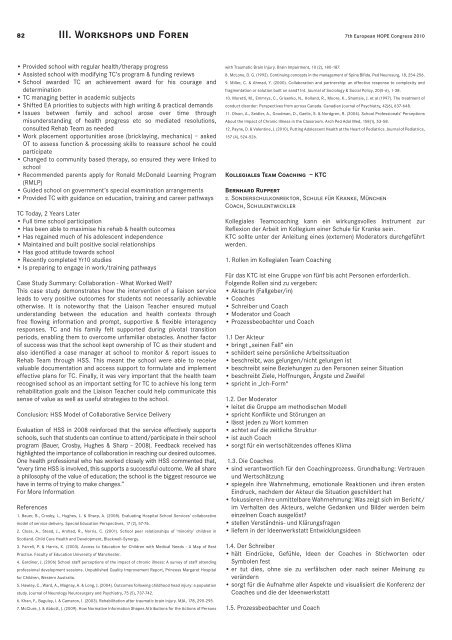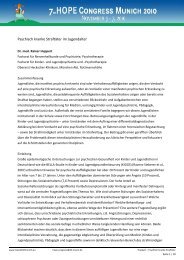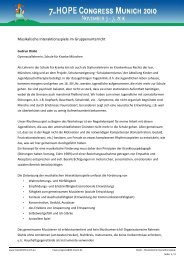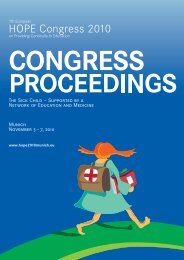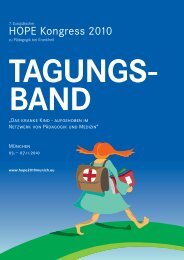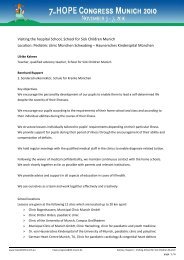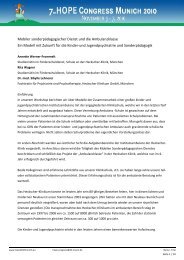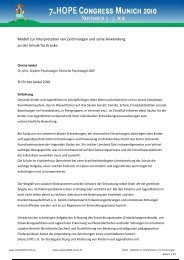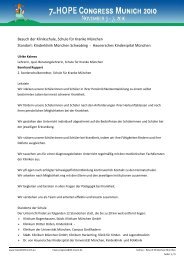HOPE Kongress 2010 - Hope Congress Munich 2010
HOPE Kongress 2010 - Hope Congress Munich 2010
HOPE Kongress 2010 - Hope Congress Munich 2010
Erfolgreiche ePaper selbst erstellen
Machen Sie aus Ihren PDF Publikationen ein blätterbares Flipbook mit unserer einzigartigen Google optimierten e-Paper Software.
82 7th European <strong>HOPE</strong> <strong>Congress</strong> <strong>2010</strong><br />
• Provided school with regular health/therapy progress<br />
• Assisted school with modifying TC’s program & funding reviews<br />
• School awarded TC an achievement award for his courage and<br />
determination<br />
• TC managing better in academic subjects<br />
• Shifted EA priorities to subjects with high writing & practical demands<br />
• Issues between family and school arose over time through<br />
misunderstanding of health progress etc so mediated resolutions,<br />
consulted Rehab Team as needed<br />
• Work placement opportunities arose (bricklaying, mechanics) – asked<br />
OT to assess function & processing skills to reassure school he could<br />
participate<br />
• Changed to community based therapy, so ensured they were linked to<br />
school<br />
• Recommended parents apply for Ronald McDonald Learning Program<br />
(RMLP)<br />
• Guided school on government’s special examination arrangements<br />
• Provided TC with guidance on education, training and career pathways<br />
TC Today, 2 Years Later<br />
• Full time school participation<br />
• Has been able to maximise his rehab & health outcomes<br />
• Has regained much of his adolescent independence<br />
• Maintained and built positive social relationships<br />
• Has good attitude towards school<br />
• Recently completed Yr10 studies<br />
• Is preparing to engage in work/training pathways<br />
Case Study Summary: Collaboration - What Worked Well?<br />
This case study demonstrates how the intervention of a liaison service<br />
leads to very positive outcomes for students not necessarily achievable<br />
otherwise. It is noteworthy that the Liaison Teacher ensured mutual<br />
understanding between the education and health contexts through<br />
free flowing information and prompt, supportive & flexible interagency<br />
responses. TC and his family felt supported during pivotal transition<br />
periods, enabling them to overcome unfamiliar obstacles. Another factor<br />
of success was that the school kept ownership of TC as their student and<br />
also identified a case manager at school to monitor & report issues to<br />
Rehab Team through HSS. This meant the school were able to receive<br />
valuable documentation and access support to formulate and implement<br />
effective plans for TC. Finally, it was very important that the health team<br />
recognised school as an important setting for TC to achieve his long term<br />
rehabilitation goals and the Liaison Teacher could help communicate this<br />
sense of value as well as useful strategies to the school.<br />
Conclusion: HSS Model of Collaborative Service Delivery<br />
Evaluation of HSS in 2008 reinforced that the service effectively supports<br />
schools, such that students can continue to attend/participate in their school<br />
program (Bauer, Crosby, Hughes & Sharp - 2008). Feedback received has<br />
highlighted the importance of collaboration in reaching our desired outcomes.<br />
One health professional who has worked closely with HSS commented that,<br />
“every time HSS is involved, this supports a successful outcome. We all share<br />
a philosophy of the value of education; the school is the biggest resource we<br />
have in terms of trying to make changes.”<br />
For More Information<br />
References<br />
1. Bauer, B., Crosby, I., Hughes, L. & Sharp, A. (2008). Evaluating Hospital School Services‘ collaborative<br />
model of service delivery. Special Education Perspectives, 17 (2), 57-76.<br />
2. Closs, A., Stead, J., Arshad, R., Norris, C. (2001). School peer relationships of ‘minority’ children in<br />
Scotland. Child Care Health and Development, Blackwell-Synergy.<br />
3. Farrell, P. & Harris, K. (2003). Access to Education for Children with Medical Needs - A Map of Best<br />
Practice. Faculty of Education University of Manchester.<br />
4. Gardiner, J. (2006) School staff perceptions of the impact of chronic illness: A survey of staff attending<br />
professional development sessions. Unpublished Quality Improvement Report, Princess Margaret Hospital<br />
for Children, Western Australia.<br />
III. Workshops und Foren<br />
5. Hawley, C., Ward, A., Magnay, A. & Long, J. (2004). Outcomes following childhood head injury: a population<br />
study. Journal of Neurology Neurosurgery and Psychiatry, 75 (5), 737-742.<br />
6. Khan, F., Baguley, I. & Cameron, I. (2003). Rehabilitation after traumatic brain injury. MJA, 178, 290-295.<br />
7. McClure, J. & Abbott, J. (2009). How Normative Information Shapes Attributions for the Actions of Persons<br />
with Traumatic Brain Injury. Brain Impairment, 10 (2), 180-187.<br />
8. McLone, D. G. (1992). Continuing concepts in the management of Spina Bifida. Ped Neurosurg, 18, 254-256.<br />
9. Miller, C. & Ahmad, Y. (2000). Collaboration and partnership: an effective response to complexity and<br />
fragmentation or solution built on sand? Int. Journal of Sociology & Social Policy, 20(5-6), 1-38.<br />
10. Moretti, M., Emmrys, C., Grisenko, N., Holland, R., Moore, K., Shamsie, J. et al (1997). The treatment of<br />
conduct disorder: Perspectives from across Canada. Canadian Journal of Psychiatry, 42(6), 637-648.<br />
11. Olson, A., Seidler, A., Goodman, D., Gaelic, S. & Nordgren, R. (2004). School Professionals‘ Perceptions<br />
About the Impact of Chronic Illness in the Classroom. Arch Ped Adol Med, 158(1), 53-58.<br />
12. Payne, D. & Valentine, J. (<strong>2010</strong>). Putting Adolescent Health at the Heart of Pediatrics. Journal of Pediatrics,<br />
157 (4), 524-526.<br />
Kollegiales Team Coaching – KTC<br />
Bernhard Ruppert<br />
2. Sonderschulkonrektor, Schule für Kranke, München<br />
Coach, Schulentwickler<br />
Kollegiales Teamcoaching kann ein wirkungsvolles Instrument zur<br />
Reflexion der Arbeit im Kollegium einer Schule für Kranke sein.<br />
KTC sollte unter der Anleitung eines (externen) Moderators durchgeführt<br />
werden.<br />
1. Rollen im Kollegialen Team Coaching<br />
Für das KTC ist eine Gruppe von fünf bis acht Personen erforderlich.<br />
Folgende Rollen sind zu vergeben:<br />
• AkteurIn (Fallgeber/in)<br />
• Coaches<br />
• Schreiber und Coach<br />
• Moderator und Coach<br />
• Prozessbeobachter und Coach<br />
1.1 Der Akteur<br />
• bringt „seinen Fall“ ein<br />
• schildert seine persönliche Arbeitssituation<br />
• beschreibt, was gelungen/nicht gelungen ist<br />
• beschreibt seine Beziehungen zu den Personen seiner Situation<br />
• beschreibt Ziele, Hoffnungen, Ängste und Zweifel<br />
• spricht in „Ich-Form“<br />
1.2. Der Moderator<br />
• leitet die Gruppe am methodischen Modell<br />
• spricht Konflikte und Störungen an<br />
• lässt jeden zu Wort kommen<br />
• achtet auf die zeitliche Struktur<br />
• ist auch Coach<br />
• sorgt für ein wertschätzendes offenes Klima<br />
1.3. Die Coaches<br />
• sind verantwortlich für den Coachingprozess. Grundhaltung: Vertrauen<br />
und Wertschätzung<br />
• spiegeln ihre Wahrnehmung, emotionale Reaktionen und ihren ersten<br />
Eindruck, nachdem der Akteur die Situation geschildert hat<br />
• fokussieren ihre unmittelbare Wahrnehmung: Was zeigt sich im Bericht/<br />
im Verhalten des Akteurs, welche Gedanken und Bilder werden beim<br />
einzelnen Coach ausgelöst?<br />
• stellen Verständnis- und Klärungsfragen<br />
• liefern in der Ideenwerkstatt Entwicklungsideen<br />
1.4. Der Schreiber<br />
• hält Eindrücke, Gefühle, Ideen der Coaches in Stichworten oder<br />
Symbolen fest<br />
• er tut dies, ohne sie zu verfälschen oder nach seiner Meinung zu<br />
verändern<br />
• sorgt für die Aufnahme aller Aspekte und visualisiert die Konferenz der<br />
Coaches und die der Ideenwerkstatt<br />
1.5. Prozessbeobachter und Coach


